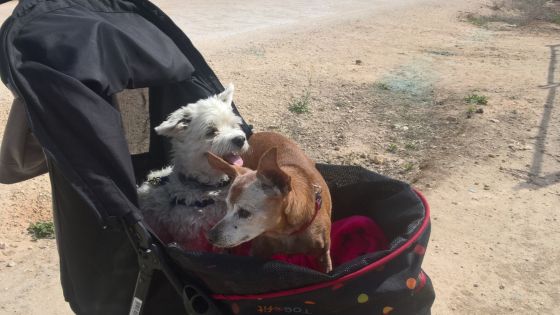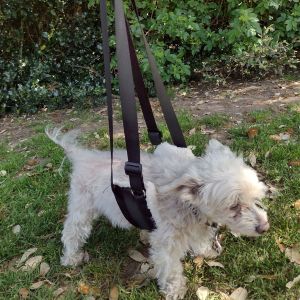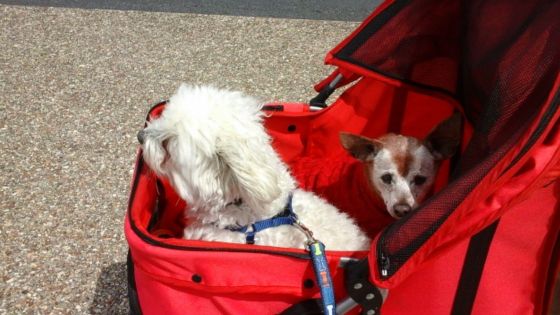Just because your senior dog is slowing down, it doesn’t have to mean the end of outings and adventures.
From strollers and wagons to harnesses and ramps, there’s no shortage of products to help your dog get around.
Who Can Benefit from Mobility Aids?
Dogs…
- suffering from arthritis, hip dysplasia or joint pain of any kind
- recovering from surgery or injury and have to take it easy
- finding it harder to climb/jump
Humans…
- who are having trouble or are simply unable to lift their dog
Is Your Dog…
- Staying in bed longer?
- Having trouble getting out of bed?
- Lying down really slowly?
- Going for shorter walks, or doesn’t want to walk at all?
- Not as interested in playing?
Many people assume these are natural signs of aging and ignore them. While they may be part of the aging process, they shouldn’t be ignored because they could indicate a problem. Please make an appointment to see your vet as soon as possible. Catching a problem early increases the likelihood it can be cured or at least managed.
In addition to mobility aids, your dog may benefit from one or more of the options discussed below. Be sure to have a chat with your vet and see what he or she has to say.
I recommend you read ⇒ “5 Effective Ways to Reduce Pain in Dogs with Arthritis”
Mobility Aids
Dog Stroller

Our dog stroller has been an incredible help in ways almost too numerous to mention.
I originally decided to get one because of a favorite vet. I’m very particular about who cares for my animals, and when I find one I trust I will make an effort for continuity of care. We had moved so had to rely on public transport to get to appointments.
Red was older and blind and while she had no trouble walking, she was very slow. A 20 minute hike over a bridge would take forever, and although she only weighed 10lbs, carrying her quickly felt like 50. Hence the stroller!
I used it to bring her to the beach when I joined my husband and other dog Jack in the summer, and when we went for days out. Why leave her behind just because she couldn’t walk too far?
They aren’t only helpful for older dogs though!
I couldn’t have predicted how much it would benefit Jack as well. After running around like a maniac at the beach or in the park, he would be so pooped he’d hitch a ride part of the way home.
A few years ago Jack became paralysed, losing the use of his back legs in a matter of hours. After a visit to the specialist hospital where an MRI showed a disc had exploded, he underwent spinal surgery. After 8 days in the hospital he came home, and of course wasn’t able to walk. I didn’t want him to be bored staying in a cage all day, only getting out to pee and poop, so with the neurologist’s permission I would take him in the stroller for a walk around the neighbourhood.
As he improved and was able to walk with the support of a sling (that I will talk about next), I would bring the stroller with us and when his allotted walk time was up, back in the stroller he went.
We used it for about 2 months twice a day, and being such an active dog I’m sure he would have been bored and depressed if he couldn’t get out and about. I certainly couldn’t carry him!
“Should You Buy a Dog Stroller”
Dog Support Sling

The sling is another mobility aid you will find useful if your dog is having trouble walking for whatever reason.
When Jack was recovering from spinal surgery we used a sling while walking him. At the beginning it was because he was unable to move his back legs, but even as he started to regain movement, he needed the support it provided.
Because Jack was a small dog, a piece of fabric from a t shirt was more than enough support. As the years passed and he developed other mobility issues we bought a rear lifting harness which was such a big help taking the pressure off his wonky legs. You can see that in the picture above.
Dog Ramp

Before I talk about ramps, I wanted to share this picture with you. Several years ago we adopted an 8 year old puppy mill rescue named Saffy. Long story short, she had been in a cage breeding for 8 years she had no idea how to use stairs. She would literally stumble up them, then fall down them so my husband built this ramp. It’s been helpful ever since for any dog with mobility issues.
Sadly, lots of dogs get left back from family car trips because they can’t get into the car on their own, and their humans can’t lift them. A dog ramp is the perfect solution.
There are styles and sizes galore, with a variety of price ranges to suit most budgets.
Some are telescoping so their reach is far, others fold, some turn into steps and I’ve even seen one that rolls. Pay attention to how much traction the ramp you’re considering has, you don’t want your dog slipping if it gets wet. Steepness of incline is also key. Too short and too steep, your dog may not be able to use it. A longer more gradual incline is best.
Doesn’t this sound perfect, teamed up with a pet stroller? They both fold for easy storage in the car, one helps your dog in and out, the other when you arrive.
By the way, there are also ramps that can be used alongside the bed or for joining you on the couch. If you are thinking of indoor use, be aware of the amount of floor space it will take up and how far out it will reach. You don’t want to create a tripping hazard.
Pet Steps
Pet steps are another great tool to help your dog reach his favorite spot on your bed or couch. Taking up less floor space than a ramp, they are less of a tripping hazard and can be easier to move around, especially because some even have a carry handle. Available in 2, 3 or 4 steps, they come in many different styles, designs and materials.
Dog Wheelchair
I would imagine the thought of a dog wheelchair raises a lot of emotions for you. When my husband and I were meeting with the neurologist to discuss Jack’s paralysis, I brought up the topic of a wheelchair. Although our amazing doctor Ed was quite confident Jack would regain the use of his legs (which he did!), I thought it was important to discuss how we felt about it in advance, just in case.
Seeing how resilient Jack had been during his recovery, and me having a hard time keeping up with him when only his front legs were working, I have no doubt he would have adapted to rolling around, and still have a great quality of life.
I’m relieved he didn’t need the wheels, but delighted they exist as an option for other dogs who have had a different outcome. It means they can still have fun and happy lives with their families.
Dog Boots
Another fantastic, multi-functional product are dog boots.
Hopefully your dog is more agreeable then my little 15 year old Red. I was in Canada with her one winter – heavy snow, ice and of course lots of salt. Needless to say it was too painful for her to walk, so I bought her booties. I wish I had a video of that experience!! She weighed 10lbs, but believe me when she didn’t want to do something, she had the strength of a dog 10x her size. Long story short she was agreeable to paw wax so we settled on that.
The boots are a wonderful solution for dogs that drag their feet due to join pain, or are unsteady/slipping walking on certain surfaces.
In our case they are something Jack would have benefitted from, especially if his recovery had taken longer. Even though we did walk him with a sling, his back legs would drag, and if we went over a few stones he would scrape the top of his paws. You can imagine how careful you have to be, but things happen and he did develop a sore.
The solution was to wrap his paw in a bandage when we were out which worked brilliantly, then once we were home he would spend time and effort pulling it off. Boots would have been ideal, I wish I had thought of it from the beginning. Having had no experience with a paralysed dog, and thinking of booties as something only needed for salted sidewalks and roads, it’s one of those “live and learn” situations.
Leg Supports and Splints
Depending on the issue, there are supports that totally immobilise the leg using a hard splint if no movement is required. There are also wraps and supports for more moderate conditions where some movement is allowed or even encouraged.
How to Choose the Right Mobility Aids for Dogs – Conclusion
I don’t know about you, but I find this information positive and encouraging. I have personally used (I should say my dogs) almost every item on this list, and the benefits cannot be overstated. It has made life so much easier and more comfortable for all of us.
Please don’t let your dog feel pain or spend the rest of his life in bed because you believe it’s natural. Speak to your vet about treatment options, and consider these mobility aids for dogs to help yours enjoy life again.
I’ve been rescuing and caring for senior dogs since 2009. From vision and hearing loss to obesity, dementia, kidney disease, liver issues, cardiac problems, Cushing’s, mobility challenges and more, you could say I’ve dealt with and learned a lot! In addition to my hands on experience, I’ve taken many courses and earned several qualifications to keep learning how to help senior dogs and they include: Senior Dog Enrichment, Understanding Canine Anxiety (diploma), Care of the Senior Pet (certificate), Pet Bereavement Counsellor (diploma) and I’m a Certified Pet Loss Grief Support Coach.
